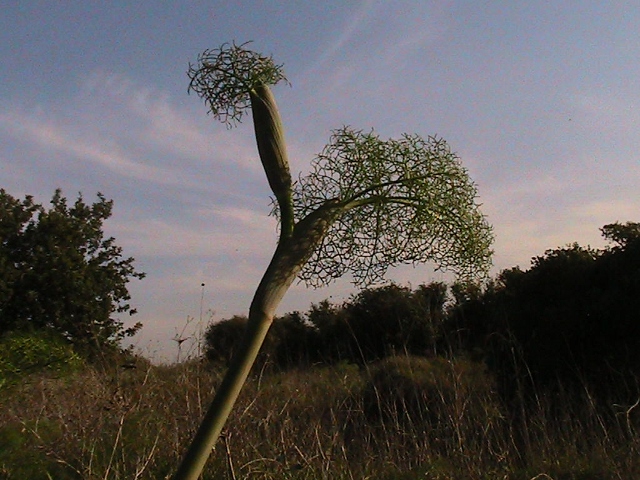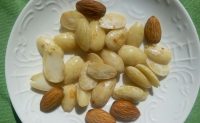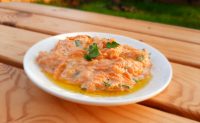Like umbrellas after the rain
The healing powers of the Umbelliferae (Apiaceae) plants
By Eyal Shpringer

Recently, I’m into families. This doesn’t refer to more frequent visits to my aunt in Tel-Aviv, but to an increasingly growing interest in botanical families of edible and healing plants, and the way in which they appear on our plate and affect our health.
Why umbrellas then?
A whole group of vegetables and herbs that we eat belong to the Umbelliferae family. After the rains, towards the end of spring, thousands of white umbrellas open up in the open fields. Plants of the Umbelliferae family present wide, umbrella-like flowers on a high stem. The wild plants in this family include the wild carrot (Daucus carota), which can serve as an edible plant, the Ammi visnaga, a healing plant for treating angina pectoris and urinary tract stones, and the hemlock (Conium maculatum), the poison plant that was used to execute the Greek philosopher Socrates.
Umbrellas in the fridge
If you haven’t yet understood what these Umbrels are, you should open the fridge. If you’ve encountered a carrot, parsley, celery, fennel, dill or coriander – be assured that you are hosting members of the Umbelliferae family. Smell them, they all share a smell that is related to their medicinal qualities.
The parallelism between form and function
In Chinese medicine, as in many traditional medicine methods, it is customary to present the parallelism between the plant’s appearance and its medical effect. In the past, such an approach was called “the signature theory”. For instance, plants with a man-shaped root were known as strengthening plants.
The Panax ginseng, for instance, whose Chinese name is Ren Shen – “the man root”, with the elderly man’s shape that characterizes it, is used for general strengthening purposes. The medical mandrake (Mandragora autumnalis), a common herb in the middle east, whose root is also human-shaped, is used in the traditional medicine traditions of the Middle-east for treating fertility problems, i.e. for treating difficulties in creating human beings.
The return to the center
When plants of the Umbelliferae family are observed (for instance, the carrot), it appears that their whole power is concentrated along a longitudinal line: the shape of the root is skewer-like, long and sharpened, the stem is long and straight, and only the flower above spreads widthwise, like an umbrella. A review of the traditional medical indications of the Umbelliferae plants demonstrates that they all have the ability to return the body to its center, to normal functioning. The plants of this family serve to return all the bodily systems to the midline and ballance.
Plants such as the Angelica Sinensis, as well the carrot seeds, “return to the midline” the functioning of the female sexual system and the hormonal functioning. The Angelica is called Danggui in Chinese, a name which in free translation means: “Must return”. This name was given to Angelica because it helps women “return” their menstruation and rehabilitate the functioning of the hormonal system.
Plants such as the Ammi Visnaga return the heart’s activity to normal functioning.
The Ligusticum-Chuanxiong, a member of this family, can be used to treat headaches and dizziness and to “return” the sense of balance. Many other plants in this family are used to treat joint diseases and anemia and to improve the functioning of the digestive system.
The digestive system returns to normal
In Chinese medicine, the digestive system is considered the center of the body. The first stage in the healing process is to ensure proper digestion. The Umbelliferae are experts at returning the equilibrium to the digestive system and improving its functioning. This effect stems mainly from the aromatic-fragrant compounds that are found in them. The fragrant nature of the Umbelliferae plants and herbs calms the irritable intestine muscles and stimulates the secretion of digestive enzymes. The aromatic oils that appear in plants of this family have an anti-parazitic activity.
Edible Umbelliferae
I have chosen to present several of my favourite edible herbs from the Umbelliferae plant family:
Cumin: Cumin is one of the simplest and most widespread spices. It helps prevent gas in the digestion system and stomach pain, helps to absorb nutrients and eases pre-menstrual pain. In Indian medicine, Cumin serves to improve the absorption of minerals from the food and support the health of the pelvic organs.
Coriander seeds: Even the Rambam, a famous Jewish doctor from the Middle Ages, contended that a woman who eats coriander will have beautiful and plump sons. Coriander also prevents gas and stomach pains. The traditional approaches are divided on the healing properties of Coriander. According to Chinese medicine, its quality is warm, but according to Ayurveda – it cools.
However, in the Ben Cao Gang Mu, the Materia Medica that was written by the 16th-century Chinese doctor Li Shi Zhen, coriander serves to treat mainly warmth conditions such as bloody diarrhoea, warmth in the limbs, vesicle rash and measles. In addition, Coriander is used for treating many other conditions, including helping in digesting cereals, meat and fish, regulation of the five organs, regulation of the movement of the small and large intestine, movement of Chi in the lower abdomen, decreasing headaches, and opening the heart orifices. It can be used as a herb or as a component of tea infusion on warm summer days.
Celery seeds: Celery seeds, aside from improving digestion, are varying, constituting a popular medicine for treating high blood pressure, and in conditions of excessive uric acid in the blood due to eating a great deal of meat (gout).
Ajowan: Ajowan is a relatively new spice in the west, its seeds resemble celery seeds, but their aromatic taste is more remindful of thyme. Ajowan is very popular in Indian medicine and in Unani medicine. It is highly efficient in treating the accumulation of phlegm in the respiratory system, improving breastfeeding and preventing intestine parasites. It is also attributed to the ability to encourage a clear consciousness and express oneself clearly and fluently.
Hing: The herb is known by the name Asafoetida, produced from an uncultivated plant called Ferula Communis. Hing is the dried resin that is produced from the stem and root of the Ferula Communis. The spice, which can be purchased in Indian food stores, is added to legumes dishes. It is considered a spice with a hot quality, and of all the Umbelliferae, it is most efficient in improving digestion the absorption and for preventing Flatulence and stomach pains. If there is a baby at home suffering from Colic, babies’ stomach pains, Hing is customarily mixed with some oil and the oil is smeared on the navel. Relief from pain is usually swift.
Someone is taking care of you
The Umbrels are at the peak of their glory in springtime when their flowering umbrellas decorate the fields. According to Chinese medicine, spring is the season that is related to processes of growth and development. The Umbelliferae family plants enable an inner order that returns us home to the central axis, to the normal functioning of the various body systems. This axis allows for an experience of health and inner freedom.
Food has been used for maintaining health throughout history. Until some decades ago, knowledge regarding the use of spices and food for relieving and treating illnesses was preserved in each family and passed on from generation to generation. The Umbelliferae family members hold some of this ancient knowledge and are waiting to come back and distribute this knowledge in your kitchen if you only let it happen.
Eyal Shpringer, a Chinese medicine therapist and lecturer, specializes in nutrition and diagnosis according to various traditional approaches. Founder of the Traditional Medicine Center and leader of the specialization course for nutrition therapists at this Center.
Additional reading:
An effective and natural way to treat mouth sores-aphtha


